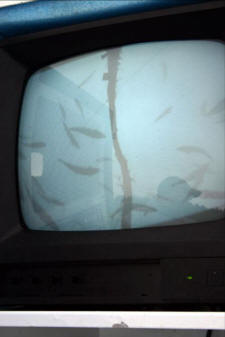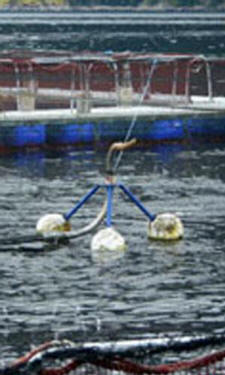Aquatic Animal Health

Canada’s reputation for high quality fish and seafood depends on keeping our wild and farmed aquatic animals protected against serious infectious diseases. National attention to aquatic animal health has grown quickly over the last decade due to an increase in volume and diversity of live and fresh seafood trade around the world.
As with any other animal or plant food producing system, fish and shellfish farmers need to pay close attention to their stocks for signs of any disease that could affect their stock and the aquatic environment.
Fisheries and Oceans Canada (DFO) works with the Canadian Food Inspection Agency’s (CFIA) to deliver the National Aquatic Animal Health Program (NAAHP). The NAAHP improves protection of Canadian aquaculture and wild fisheries from diseases to maintain the country’s competitive access to seafood trade markets. The NAAHP will complement measures already in place – on the farm and through provincial aquatic animal health management programs.
Please visit the links below to learn more about aquatic animal health.
National Aquatic Animal Health Program
PDF version
Disease is a significant threat to sustainable farmed and wild aquatic stocks world wide.
In the Spring 2005 budget, the Government of Canada announced a $59 million investment over five years with permanent funding thereafter for the Canadian Food Inspection Agency (CFIA) and Fisheries and Oceans Canada (DFO) to implement and deliver a National Aquatic Animal Health Program (NAAHP). This new program is designed to meet international aquatic animal health management standards to protect Canadian aquatic resources (wild and farmed) from serious infectious diseases and to maintain competitive international market access.
What is the National Aquatic Animal Health Program (NAAHP)?
The NAAHP is a science-based regulatory program for aquatic animal diseases which have been designated reportable or notifiable in Canada because of their potential impact on trade and our economy. The program consists of measures needed to prevent, control and/or eradicate aquatic animal diseases of concern. The NAAHP is modeled after Canada’s internationally recognized terrestrial animal health program, and will respect the health measures of the Aquatic Animal Health Code of the World Organization for Animal Health (OIE).
The NAAHP is comprised of the following key elements for listed diseases of concern:
- Listing of aquatic animal diseases meeting international and national criteria for mandatory reporting
- Legislation, regulations and policies
- Surveillance (early detection), monitoring and reporting
- Zonation (regionalization)
- Disease databases
- Laboratory diagnostic testing and capacity building
- Quality Assurance/Quality Control
- Scientific research and technology development
- Import controls
- Export certification
- International relationships (influencing setting of standards, trade negotiations)
- Contingency planning
- Disease control and eradication (containment standards and quarantine, disease preparedness and response etc.)
- Education and training
- Risk analysis
- Awareness
- Animal welfare
- Record keeping (tracking and tracing)
- Codes of practice
- Hatchery Program
Why does Canada need a National Aquatic Animal Health Program?
As a member of the OIE and the World Trade Organization, Canada is obliged to implement OIE standards for trade purposes, including trade in aquatic and terrestrial animals. In addition, Canada is a member of the Food and Agriculture Organization (FAO) and signatory to the Code of Conduct for Responsible Fisheries aimed at conservation of resources for sustainable economic productivity. Canada’s major trading partners are adopting regulatory frameworks for their own aquatic animal health programs to meet these international scientific standards. Canada may be required to attest, for export purposes that aquatic animals and their products originate from regions, farms or sites that are free of reportable or notifiable diseases.
Who is responsible for the NAAHP?
The Minister of Agriculture and Agri-Food, who is responsible for the CFIA, and the Minister of Fisheries and Oceans are jointly implementing the federal responsibilities for the NAAHP. This collaboration between Canada’s veterinary services and fisheries authority will greatly facilitate Canada’s capacity to meet international obligations for aquatic animal health management.
The CFIA provides the overall program lead for the NAAHP under the legislative authority of the Health of Animals Act and Regulations. The Agency is responsible for the disease surveillance/monitoring protocols and control measures for reportable diseases. DFO delivers and oversees the National Aquatic Animal Laboratory System (NAAHLS).
Since the management of the wild and aquaculture industries is a shared responsibility in Canada, the NAAHP is designed to respect federal and provincial/territorial jurisdictions. Expertise and collaboration from provinces/territories and industry will continue to be sought to minimize duplication or gaps in an effort to ensure that all aquatic animal diseases are well managed by government and industry.
How are stakeholders consulted on NAAHP?
The Aquatic Animal Health Committee (AAHC) has members which include the Canadian Aquaculture Industry Alliance (CAIA), the Fisheries Council of Canada (FCC), the Aboriginal Aquaculture Association, the Canadian Veterinary Medical Association (CVMA), provincial representatives, Fisheries and Oceans Canada and the Canadian Food Inspection Agency. The AAHC advises the CFIA and DFO on matters relating to the development and implementation of the NAAHP. Information will be shared extensively with all stakeholders as major components of the NAAHP evolve. This approach will ensure a comprehensive and coordinated aquatic animal health management program for Canada.
Scientific Research
Canadian Science Advisory Secretariat (CSAS)
CSAS coordinates the peer review of scientific issues for Fisheries and Oceans Canada. CSAS works with scientists across the department to develop integrated overviews of issues in fish stock dynamics, ocean ecology and use of living aquatic resources, like aquaculture, and to identify emergent issues quickly.
Read more …
Synopsis of Infectious Diseases and Parasites of Commercially Exploited Shellfish
Aquaculture Collaborative Research and Development Program (ACRDP)
The
Aquaculture Collaborative Research and Development Program (ACRDP) is a DFO initiative to increase the level of collaborative research and development activity between the aquaculture industry and the department, and in some instances with other funding partners.
Read more …
There are numerous studies underway on aquatic animal health issues related to aquaculture species. For a list of current projects, please visit the
ACRDP website to learn more.
Nutrition and Feed
Farmed fish are fed small, nutrient-dense, dry pellets. Different feeds are used depending on the life stage of the fish. The feeds have been developed to meet the nutritional requirements of healthy growing fish and contain a variety of ingredients, with fish protein meal and fish oil being the major ones. They also include vegetable proteins and cereals.

Feed is the most significant cost factor in operating a salmon farm. Approximately 40 per cent of the salmon farm’s operating cost is spent on feed. Therefore, it is important to avoid wasting
 food. Farmed fish can convert food to energy very well, and today’s fish feed is easier to digest. Underwater video cameras are used to ensure that a minimal amount of uneaten food is settling beneath the net pen. This helps to ensure feed conversion ratios (the amount of food required to produce fish) are as low as possible. Marine and freshwater environments also have a large capacity to absorb organic materials, especially where there are strong currents. Strategic location of fish farms, combined with mitigation measures such as allowing for periods of inactivity (site fallowing), help to minimize the environmental effects. food. Farmed fish can convert food to energy very well, and today’s fish feed is easier to digest. Underwater video cameras are used to ensure that a minimal amount of uneaten food is settling beneath the net pen. This helps to ensure feed conversion ratios (the amount of food required to produce fish) are as low as possible. Marine and freshwater environments also have a large capacity to absorb organic materials, especially where there are strong currents. Strategic location of fish farms, combined with mitigation measures such as allowing for periods of inactivity (site fallowing), help to minimize the environmental effects.
 The Canadian feed industry endeavors to source quality raw materials from areas around South America, where there has been a consistent record of quality and safety. Feed manufacturers test their feed ingredients routinely to ensure the production of a high-quality product that meets government health and safety standards. Canadian feed companies are currently researching the development of grain-based feeds for salmon aquaculture. Currently, feeds for farmed salmon are made up of 30 to 40 per cent fishmeal and 20 to 25 per cent fish oil. Over time, these numbers are expected to decline as more grains are introduced to salmon feed. The Canadian feed industry endeavors to source quality raw materials from areas around South America, where there has been a consistent record of quality and safety. Feed manufacturers test their feed ingredients routinely to ensure the production of a high-quality product that meets government health and safety standards. Canadian feed companies are currently researching the development of grain-based feeds for salmon aquaculture. Currently, feeds for farmed salmon are made up of 30 to 40 per cent fishmeal and 20 to 25 per cent fish oil. Over time, these numbers are expected to decline as more grains are introduced to salmon feed.
For more information on feed, please visit these links:
DFO’s ACRDP projects involving research on fish feed:
Alternative protein research in diets for Atlantic salmon
Developing optimal grow-out culture systems and diets for green sea urchin
juveniles
Evaluation of effects of low-phosphorus diets on immune system function
Feed trials in CanadaNote: This page contains links to Web sites not
under the control of the Government of Canada. For further information on
our hyperlinking practices, please refer to the
Hyperlinking
Notice. |
